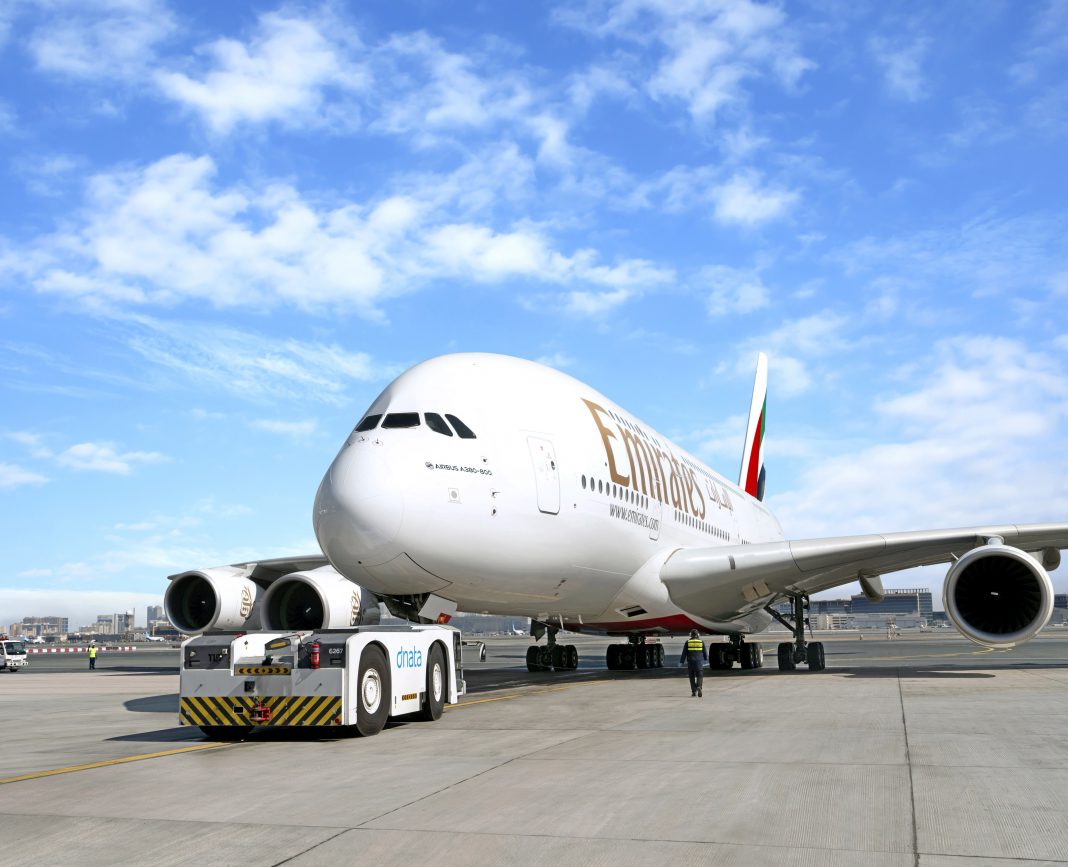The Emirates Group recorded an annual loss of AED3.8 billion ($1 billion) for the 2021-22 financial year due to the ongoing Covid-19 pandemic impact, a significant improvement from last year with dnata returning to profitability.
The group had posted a loss of AED22.1 billion ($6 billion) in the previous year.
The 2021-22 Annual Report (for the year ending March 31, 2022) showed strong recovery across its businesses with dnata returning to profitability, and significant revenue improvements across both Emirates and dnata as the group rebuilt its air transport and travel-related operations which were previously cut-back or curtailed by the Covid-19 pandemic.
The group’s revenue was AED66.2 billion ($18.1 billion), an increase of 86 per cent over last year’s results. The group’s cash balance was AED25.8 billion ($7 billion), up 30 per cent from last year mainly due to strong demand across its core business divisions and markets, triggered by the easing of pandemic-related restrictions.
Sheikh Ahmed bin Saeed Al Maktoum, Chairman and Chief Executive, Emirates Airline and Group, said: “This year, we focused on restoring our operations quickly and safely wherever pandemic-related restrictions eased across our markets. Business recovery picked up pace particularly in the second half of the year. Robust customer demand drove a huge improvement in our financial performance compared to our unprecedented losses of last year and we built up our strong cash balance.
“The health and safety of our people and customers remained a key priority as the world navigated its second full year of the pandemic. Across Emirates and dnata, we responded to dynamic market conditions with agility, and introduced innovative products and services to meet our customers’ needs and provide them with the best possible experience.
“2021-22 was also a significant year as the UAE marked its 50th anniversary and hosted the world at Expo 2020 Dubai which generated increased global engagement and visitation to the UAE. The Emirates Group was proud to play our part in contributing to the Expo’s success and to the UAE’s jubilee events.”
In 2021-22, Emirates received a further capital injection of AED3.5 billion ($954 million) from its ultimate shareholder, the Government of Dubai, and the group tapped on various industry support programs and availed a total relief of nearly AED0.8 billion in 2021-22, he said.
As Emirates and dnata ramped up operations, employees previously on furlough or made redundant were recalled and rehired, and new recruitment drives were held to replenish the group’s talent pool and boost its future capabilities. As a result, the group’s total workforce increased by 13 per cent to 85,219 employees, representing over 160 different nationalities.
In 2021-22, the group collectively invested AED7.9 billion ($2.2 billion) in new aircraft and facilities, and the latest technologies to position the business for recovery and future growth. It also continued to progress its environmental strategy focused on reducing carbon emissions, consuming resources responsibly, and conserving wildlife and habitats. During the year, the Group supported community, humanitarian and philanthropic initiatives in its various markets, as well as innovation incubators, and other programs that nurture future solutions for industry growth.
Sheikh Ahmed said: “For the Emirates Group, 2021-22 was largely about recovery, after the toughest year in our group’s history. It’s not just about restoring our capacity, but also augmenting our future capabilities as we rebuild. Our aim is to build back better and stronger, so that we can deliver even better experiences to our customers and offer more support to the communities we serve.
“We expect the group to return to profitability in 2022-23, and are working hard to hit our targets, while keeping a close watch on headwinds such as high fuel prices, inflation, new COVID-19 variants, and political and economic uncertainty,” he added.
Emirates performance
Emirates’ total passenger and cargo capacity increased by 47 per cent to 36.4 billion ATKMs in 2021-22, as the airline continued to reinstate passenger services across its network in line with the lifting of pandemic-related flight and travel restrictions.
From 120 destinations at the start of the financial year, to increased operations and capacity growth across over 140 destinations by March 31, 2022, Emirates was able to respond dynamically to serve customer demand wherever opportunities arose, thanks to the resilience of its people and business model. In July, the airline launched a new route to Miami, bringing its total passenger gateways in the US to 12.
Emirates received its final five new A380 aircraft during the financial year, all equipped with its latest cabin interiors including Premium Economy seats. It also phased out 2 older aircraft comprising of 1 Boeing 777-300ER and 1 Freighter, leaving its total fleet count at 262 at the end of March. Emirates’ average fleet age remains at a youthful 8.2 years.
Emirates’ order book of 197 aircraft remains unchanged at this time. The airline is firmly committed to its long-standing strategy of operating a modern and efficient fleet, which underscores its “Fly Better” brand promise, as young aircraft are better for the environment, better for operations, and better for customers, the group said.
With significantly enhanced capacity deployment across most markets, Emirates’ total revenue for the financial year increased 91 per cent to AED59.2 billion ($16.1 billion). Currency fluctuations this year impacted the airline’s profitability negatively by AED348 million ($95 million).
Total operating costs increased by 30 per cent from last financial year. Cost of ownership (depreciation and amortisation) and fuel cost were the two biggest cost components for the airline in 2021-22, followed by employee cost. Fuel accounted for 23 per cent of operating costs compared to 14 per cent in 2020-21. The airline’s fuel bill more than doubled to AED13.9 billion ($3.8 billion) compared to the previous year, driven by a higher uplift of 66 per cent in line with capacity expansion and a higher average fuel price which was up by 75 per cent, it said.
With the removal of pandemic-related flight and travel restrictions globally, the airline managed to substantially improve its financial results and reported a loss of AED3.9 billion ($1.1 billion) after last year’s AED20.3 billion ($5.5 billion) loss, and a loss margin of 6.6 per cent, significantly improved compared to 65.6 per cent last year.
Emirates carried 19.6 million passengers (up by 199 per cent) in 2021-22, with seat capacity up by 150 per cent. The airline reports a Passenger Seat Factor of 58.6 per cent, compared with last year’s passenger seat factor of 44.3 per cent; and a 10 per cent decline in passenger yield to 35.1 fils (9.6 US cents) per Revenue Passenger Kilometre (RPKM), due to the change in route mix, fares and currency. Seat load factor and yield results cannot be compared against the previous year’s performance due to the ongoing unusual pandemic situation.
Recovery from the pandemic was felt across all dnata businesses, and in 2021-22 dnata returned to profitability with a profit of AED110 million ($30 million). With growing flight and travel activity across the world, dnata’s total revenue increased by 54 per cent to AED8.6 billion ($2.3 billion). dnata’s international business accounts for 62 per cent of its revenue.


